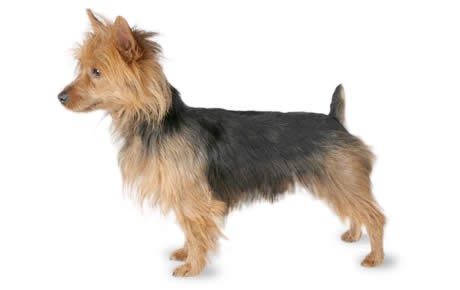Australian Terrier Breed Guide

Breed Group:
Terrier Dogs
Get 30% off
Join our Newsletter
Sign Up Today
Australian Terrier Background Info and History
The Australian Terrier was developed in the mid 19th century in Australia. This dog breed has the distinction of being the first breed officially recognized for having been developed in Australia, which occurred in 1868. The Australian Terrier was bred from a combination of breeds brought by settlers of the Australian outback during the 1800’s.
These include the Black and Tan Terrier, Irish Terrier, Yorkshire Terrier, Cairn Terrier, and Dandie Dinmont. The Australian Terrier was bred to control rodents, snakes, and to guard farms. This breed was first exported to Britain in 1887 and arrived in the United States in the 1940’s.
Temperament and Personality of Australian Terriers
Australian Terriers are a unique mix between a house dog and an outdoor working dog. They excel in both environments but crave attention. They are energetic and attentive. Aussies have a strong prey drive harkening back to their roots hunting vermin and snakes in the Australian Outback.
Australian Terrier Training Tips
Aussie’s are an energetic, small breed that will require training and socialization from a young age. In particular, they should be socialized with other animals, including household pets such as cats that can trigger their prey drive. They excel in training and require it to avoid their bossy and domineering nature.
Exercise Needs of Australian Terriers
Australian Terriers require daily exercise to keep their mind and body occupied. Expect to bring your Aussie on a daily walk, jog, or vigorous play session.
Australian Terrier Lifespan
Australian Terriers usually live to be 11-15 years old.
Australian Terrier Breed Popularity
The Australian Terrier is currently the 136th most popular AKC registered breed. Their relatively low popularity may be due to their odd mix of a house dog that requires daily exercise and lots of attention.
Feeding Requirements of Australian Terriers
This high-energy breed will need to be fed a high-quality food source that contains a good mix of proteins and fats. Avoid any foods with grain-based fillers. The average Australian Terrier weighs between 12-18 lbs., so expect to feed them ¾ to 1 cup of dry food a day, split into two meals.
Australian Terrier Grooming
The Australian Terrier grooming process requires weekly brushing to keep your dog’s coat healthy and clean. Overly frequent bathing should be avoided as it softens the coat.
Are Australian Terriers Good With Kids?
The Australian Terrier is known to be gentle and friendly with children which makes them excellent family dogs.
Health Problems of Australian Terriers
Overall, the Australian Terrier is a very hardy, healthy breed. This breed has few known health problems, except for those that sometimes affect all smaller breeds of dogs.
Patellar Luxation
Patellar Luxation in dogs is a condition that commonly occurs in smaller breeds. This condition occurs when the kneecap (patella) becomes dislocated during exercise or play. Signs of patellar luxation include sudden onset of limping or lameness during exercise or play, or hesitancy to place full weight on a limb.
This is a painful condition, so if you suspect your Australian Terrier has suffered a dislocation it is recommended to seek medical help immediately. In most cases, patellar luxation is treated surgically.
Legg-Calve-Perthes Disease (LCPD)
LCPD is another condition that occurs in small dog breeds but predominantly appears in toy and miniature varieties. With LCPD, the head of the femur that sits in the pelvis begins to disintegrate over time. As this deterioration progresses, the function of the rear hip assembly begins to worsen.
The exact cause of LCPD is unknown, but it is believed to be due to an inadequate flow of blood to the femur, which leads to degeneration and inflammation in dogs. The onset of LCPD begins with gradual lameness in the hindquarters that progressively worsens over time. This condition is treated surgically.
Other Resources
National Breed Website: Australian Terrier Club of America
Rescue: Australian Terrier Rescue Inc.
